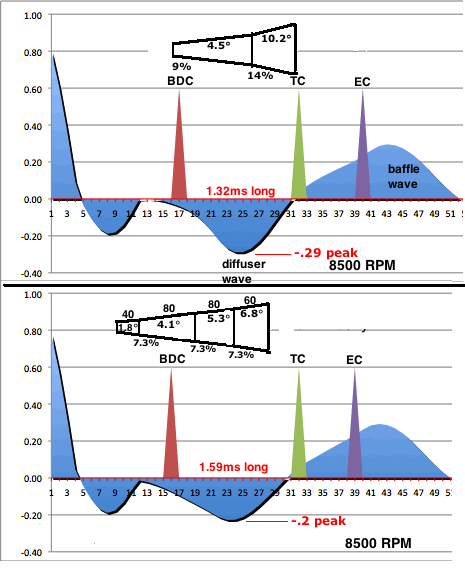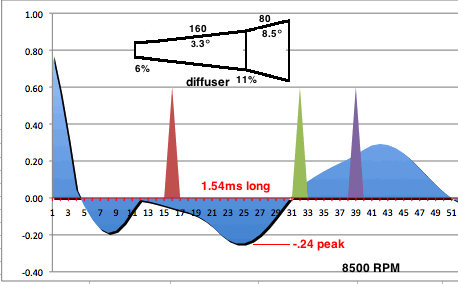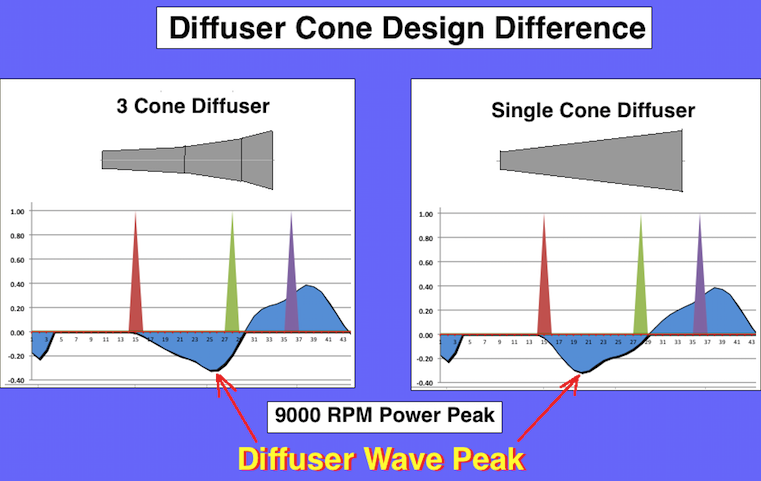| I've been passing on the warning by Blair that too much angle will cause the sonic wave to separate from the inner pipe walls with the belief that it would lessen the return wave strength. He said the beginning of the diffuser can't be more than 4 degrees but he didn't say for which diameter header which is important since it's the area change per each 10mm that affects the wave. So I used an average sized header diameter and came up with 7.3% area increase after the first 10mm. But before I came across that info I made my current pipe for my 100cc street bike. It is 180mm long and has a two stage diffuser with the first stage beginning at 4.5 degrees and 8.9% area change, and the second stage at 10.2 degrees and 14.3% area change. I just replaced it with a 4 stage diffuser with the 2nd, 3rd, and 4th stages beginning at 7.3%. (see drawing below) So it was longer with milder angles which produced a longer and weaker return wave. When I rode the bike the power was noticably weaker and didn't get any better than before till up around 8500 RPM when the power was about the same. This shows that the 4 degree limit is either false or that the wave separating from the walls does not affect the return wave negatively. Here are the two wave graphs and the only visible differences that are positive for the long diffuser is that the wave is longer and for the first 1/3rd of the diffuser wave its strength is more than the short diffuser wave. It is interesting to note that the long wave increases linearly due to each of the 3 main cones having the same beginning area change. (the first cone is an inconsequential 1.8 degrees that is 40mm long.)  So now I don't set limitations on diffuser angle but rather emphasize the peak return wave strength primarily, and the wave length secondarily. A peak diffuser wave of -.3 to -.4 is a good range to shoot for on sheet 3 of ECcalc. Having a steep angled last diffuser cone is necessary for good peak strength. If you do that and it still isn't very strong then shorten the diffuser so the angles can be steeper. The belly diameter to header diameter ratio is all important also because the less that ratio is, then the less the angles will be for the same length of diffuser. The only minimum requirement for length of diffuser is so the diffuser return wave begins to arrive back at the cylinder sometime during the trailing wave of the exhaust pulse. If it doesn't then it is too short. Here's the dimensions and the waves graph of the diffuser I installed next. It has a little less peak than I recommend but it has a 17% increase of the diffuser wave time which allows the return diffuser wave to start before the end of the exhaust trailing pulse. This diffuser has a 1.54 millisecond long return wave at 8500 RPM. This was also an experiment and it ran weaker till I enriched the mid range jetting. Then the results were about the same as the first diffuser, with maybe a little more punch when it starts to get on the pipe. I think it was Jennings who wrote that a longer diffuser helps widen the powerband. So that may be true but its also true that the longer it is the shallower the angles are which result in weaker return waves with less ability to pull in more intake charge into the crankcase and so it has to have the jetting richer but still the delivery ratio will be less with a smaller percentage of oxygen.   |